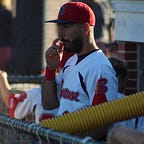Blast Motion Best Practices
As I continue to think about how to best use different types of technologies when looking at the baseball swing. I wanted to start part one of a 4 part series. Today I am going to focus on best practices when it comes to using Blast Motion Sensor. I have written in great detail about using Blast Motion Bat Sensor in this space before. So I figured I would place those articles here as well. Today I want to examine in detail how to best use the Blast Motion Sensor. Looking at the specifics of who should be using it? What does the sensor best accomplish and show us? When should we be using it? And Finally Why we should use it? Along the way I want to highlight what I believe to be the best aspects of this piece of technology and how to effectively implement it into your team or individual programming.
Bat Sensors I think should at least be used at its most basic use should come from before season testing for Bat Speed. Players and coaches should at the very least be using the sensor to measure bat speed during the on ramping process as teams come back together. Most effective practices I believe come from using the Bat Sensor at several key points during the season to evaluate how effective the player programming is.
The best metrics to focus on when using the Blast Motion sensor comes from three key metrics. Bat Speed which is simply how fast can you swing the bat. I know this will upset some people but the faster you can swing the bat the faster you can hit the baseball which is a good thing. The second metric to evaluate is Attack Angle. If anything if using this metric will give you a general idea of a players bat path. Do I think this metric is perfect. I do not, but that won’t stop me from recommending it to you as a metric that will provide insights to help your players.
Time to contact. This is going to be a new metrics that I want to examine more of. The premise when using this metric to evaluate a player is that they want to quick to contact. We don’t want to artificially shorten their swing by cuing them up to throw their hands as quickly as possible. But the key to this metric needs to be in the fact that it will give us a good indications of how the player is effectively moving their body. Players who are longer to contact are having a harder time of moving their muscles quickly. Which could at least indicate a couple of key parts of the swing to focus on depending on what the coach sees.
At a minimum players and coaches should be looking to use the Bat Sensor at the beginning of the season, and at the end at player “check out” meetings. Ideally we would reassess players every 2–3 weeks during the season to see what progress they are making. I don’t believe that the bat sensor is something which should be used every single day to examine what is happening in the swing. I think is should be used as both an assessment tool, as well as a diagnostic tool when a player is going good, or when they start to struggle.
I think that this point is something that could be drilled home with players. I believe that when we have a hitter is rolling it should be a good time to at least gather metrics on them to see what is happening. This doesn’t even need to be something that we show players. But rather gives the coaches an idea of what is happening when we are going good, so that we can go back to the sensor if things go sideways. It is a good tool for this type of assessment. Lets say that player slumps, we can try to identify what might be happening in the swing to find out if we are seeing anything different than when they were going good.
Bat Sensors are a quick, and effective way for hitters to quickly gather useful data that are actionable for players. When looking at using it either in a team setting or individual setting it is important to balance the use of the technology, and subjective information to marry what is happening in the players swing. I think that ultimately the bat sensor can be a really good tool to bring into your practice setting. It gives coaches a tool in their toolbox that they can use to collect objective information on players swings without the bias of their own ego getting into the way.
